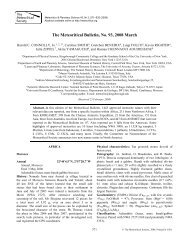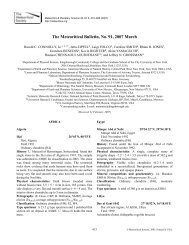Create successful ePaper yourself
Turn your PDF publications into a flip-book with our unique Google optimized e-Paper software.
580<br />
pre-3.9 Ga crust with so many impacts that<br />
isotopic clocks were constantly being reset within<br />
a heated megaregolith, until the rocks that<br />
eventually became samples were excavated to<br />
the surface regolith (sensu stricto) by a few major<br />
impacts. This might seem a plausible explanation<br />
for the paucity of pre-3.9 Ga ages, if the<br />
3.8–3.9 Ga clustering was limited to the easily<br />
reset argon age system. However, Papike et al.<br />
(1998) cite many strontium-based ages clustering<br />
near 3.8 Ga (Figure 11; the strontium-based<br />
cluster appears displaced by 20.1 Ga from the<br />
argon-based cluster, but this may be an analytical<br />
artifact). <strong>The</strong> relevance of the impact-melt age<br />
spectrum as portrayed by Ryder (1990) and<br />
Dalrymple and Ryder (1993, 1996) can still be<br />
questioned, however, on the more fundamental<br />
grounds that these authors always assumed that<br />
only samples with classic (near-subophitic)<br />
impact-melt breccia textures are appropriate for<br />
dating impact events. J. L. Warner et al. (1977)<br />
suggested that on the early (pre-3.9 Ga) <strong>Moon</strong>,<br />
where the ambient crustal temperature was still<br />
relatively close to the solidus, granulitic breccias<br />
tended to form in major impacts, in analogous<br />
proportion and position to where, on the post-<br />
3.9 Ga <strong>Moon</strong>, impact-melt breccias would form.<br />
This model, from a team of leading authorities on<br />
impactite genesis, has never been effectively<br />
refuted. As was already a point of emphasis to<br />
J. L. Warner et al. (1977), granulitic breccias are<br />
commonly older than 3.9 Ga (Figure 11).<br />
Critics of the cratering spike hypothesis also<br />
note (e.g., Chapman et al., 2002) that the Apollo<br />
,3.9 Ga impact-melt samples come exclusively<br />
from sites clustered in the central nearside, and<br />
thus are likely from preponderantly just two or<br />
three impacts: Imbrium, Serenitatis, and with<br />
greater uncertainty, Nectaris. Cratering theory<br />
(Melosh, 1989; Grieve and Cintala, 1992) indicates<br />
that the proportional yield of impact melt,<br />
as opposed to solid ejecta, is vastly higher in largebasin-forming<br />
events than in smaller-scale<br />
impacts. Warren (1996) applied this principle to<br />
the particular case of the <strong>Moon</strong>.<br />
On photogeologic–stratigraphic grounds, Nectaris<br />
is clearly older than Imbrium and Serenitatis,<br />
and two-thirds (30 out of 44) of the <strong>Moon</strong>’s stillrecognizable<br />
basins appear even older than<br />
Nectaris (Wilhelms, 1987). Impact-melt breccias<br />
of Nectaris origin are presumably present among<br />
the Apollo 16 samples, acquired ,550 km from<br />
the center of Nectaris. 40 Ar– 39 Ar ages for Apollo<br />
16 impact-melt breccias mostly cluster in the<br />
range 3.87–3.92 Ga (Papike et al., 1998;<br />
Dalrymple et al., 2001), and 3.90–3.92 Ga has<br />
become almost canonical as the age of Nectaris<br />
(e.g., Wilhelms, 1987; Dalrymple et al., 2001).<br />
But, as Korotev et al. (2002b) have noted, the<br />
absolute age of Nectaris is unclear. A large group<br />
<strong>The</strong> <strong>Moon</strong><br />
(at least 13) of Apollo 16 “light matrix breccias”<br />
(these rocks were explicitly classified as impactmelt<br />
breccias by the authoritative Stöffler et al.<br />
(1980) compilation) yielded argon ages in<br />
the range 4.12–4.26 Ga (Schaeffer and Husain,<br />
1973; Mauer et al., 1978). Mauer et al. (1978)<br />
assumed these “group 1” samples cannot be basinrelated,<br />
because they tend to be distinctly KREEPpoor<br />
compared to the other Apollo 16 impact<br />
melts; the assumption was that all impacts big<br />
enough to form basins would plumb into a KREEP<br />
layer in the lower crust. However, in light of what<br />
the Prospector data (Lawrence et al., 2002a)<br />
revealed about the extreme concentration of<br />
KREEP into the Procellarum (central-eastern<br />
nearside) region, a Nectaris provenance seems<br />
more plausible for the “group 1” samples than for<br />
the more typical, younger but unsuitably KREEPrich,<br />
impact-melt breccias from Apollo 16. Also,<br />
recent basin ejecta thickness modeling (Haskin<br />
et al., 2002) suggests that ejecta from distant<br />
Imbrium and Serenitatis outweigh ejecta from the<br />
nearby but relatively small and older Nectaris, in<br />
the upper (sampled) Apollo 16 megaregolith.<br />
Considering all of these constraints, an age of<br />
,4.2 Ga for Nectaris seems entirely possible, if<br />
not probable.<br />
<strong>The</strong> age of a fourth basin, Crisium, can, in principle,<br />
be constrained using Luna 20 samples. On<br />
photogeologic–stratigraphic grounds, Crisium<br />
appears similar in age to Serenitatis, i.e., older<br />
than Imbrium but younger than Nectaris<br />
(Wilhelms, 1987). Cohen et al. (2001) obtained<br />
argon ages for six Luna 20 rocklets and reviewed<br />
literature data (mainly from Swindle et al., 1991)<br />
for 12 others. Swindle et al. (1991) found a loose<br />
clustering of ages at 3.75–3.90 Ga and suggested<br />
that the oldest sample in this cluster,<br />
3.895 ^ 0.017 Ga, might date the Crisium impact.<br />
However, it is not even clear the sample in question<br />
is an impact-melt breccia (no thin section was<br />
made). <strong>The</strong> only two certain impact-melt breccias<br />
dated by Swindle et al. (1991) yielded ages of<br />
0.52 ^ 0.01 Ga and 4.09 ^ 0.02 Ga. Among the<br />
samples dated by Cohen et al. (2001), most are, in<br />
this author’s opinion, probably either impact-melt<br />
breccias or annealed impact-melt breccias (genuine,<br />
pristine “gabbros” seldom have grain sizes of<br />
,200 mm like rocklet 2004D; pristine troctolites<br />
seldom have grain sizes of ,100 mm like rocklet<br />
2004C). Considering all of the 13 or so Luna 20<br />
rocklets that have yielded 40 Ar– 39 Ar ages (Cohen<br />
et al., 2001) and are likely impact-melt breccias,<br />
the data (excluding the 0.52 Ga outlier) show an<br />
almost even distribution across the 3.75–4.19 Ga<br />
range. In other words, the age of the Crisium<br />
impact is not yet constrained beyond being<br />
probably within the range 3.8–4.2 Ga.<br />
From a celestial-mechanical standpoint (e.g.,<br />
Wetherill, 1981; Morbidelli et al., 2001),





